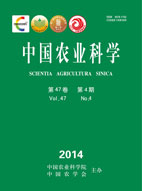-
Recognition of Rice Leaf Diseases Based on Computer Vision
- LIU Tao-1, ZHONG Xiao-Chun-2, SUN Cheng-Ming-1, GUO Wen-Shan-1, CHEN Ying-Ying-1, SUN Juan-1
-
Scientia Agricultura Sinica. 2014, 47(4):
664-674.
doi:10.3864/j.issn.0578-1752.2014.04.006
-
 Abstract
(
849 )
Abstract
(
849 )
 HTML
(
26 )
HTML
(
26 )
 PDF (858KB)
(
1581
)
PDF (858KB)
(
1581
)
 Save
Save
-
References |
Related Articles |
Metrics
【Objective】The purpose of this article was to recognize 15 kinds of rice disease located at leaf accurately, especially among the similar diseases. 【Method】 For disease spot image acquisition, the original image was got by digital camera from paddy fields and modified mean shift image segmentation algorithm was used to extract rice disease spot from the original image. For the selection and design of feature parameters, Firstly, the color moments arranged from first to third order and color histogram were selected as color feature parameters, and sphericity, eccentricity, invariant moment as shape feature parameters, and angular second moment, contrast, correlation as texture feature parameters. Secondly, junction feature parameters were designed aiming at high missing report rate of similar diseases, this feature was established based on the difference between inside, margin and periphery of disease spot, and euclidean distances of color in different regions were used to calculate this feature parameters which could describe the junction of health and disease. Thirdly, for the design of diseases identification process, the process of diseases was designed based on the key characters of each disease, in this process, diseases were distinguished by the biggest character difference. The concrete step of identification process are as follows: Firstly, color feature was used to divide all the diseases into six groups. Secondly, shape feature was used to subdivide. Finally, texture and junction feature were used for ultimate recognition. Color, shape, texture and junction feature parameters were obtained by related equation, and the parameters were divided into fifteen groups by their disease types. Fourthly, for the establishment of recognition model, the Support Vector Machine(SVM) model was applied to classify and recognize the 15 kinds of rice diseases stepwise. The images were divided into two groups, one was selected to build the model, and another to verify it. LibSVM software package was used to modeling, of which svmtrain function, svmpredict function and grid software were separately used to establish and verify the model and parameter optimization. In this research, a comprehensive study was conducted about the impact of junction feature parameters and identification process on improving accuracy.【Result】A total of 15 kinds of rice disease could be extracted and recognized by this method successfully, and the average recognition accuracy rate was up to 92.67% , average missing report rate was 7.00%, the max missing report rate and false report rate was 15.00% and 25.00%, respectively. After using junction feature parameters, recognition accuracy rate was 14.00% higher, average missing report rate was 7.50% lower, the max decreasing ranges of missing report rate and false report rate were 20.00% and 65.00%, respectively. The identification process proposed in this study could make the recognition accuracy rate 12.67% higher, missing report rate was 9.33% lower, and decreasing ranges of some diseases were more than 30.00%. In all the steps of diseases identification process, the accuracy rate of color recognition was 96.71%, missing report rate and false report rate were both under 10.00%. At the second step, the accuracy rate was 94.17%, missing report rate and false report rate were both under 15.00%. The accuracy rate of texture and junction feature step recognition was 91.5%, missing report rate and false report rate were both under 25.00%.【Conclusion】The 15 kinds of rice disease spots could be segmented from the original images based on the modified mean shift image segmentation algorithm, and the disease could be accurately classified with the method of SVM model with proper feature parameters. The junction feature parameter and the classifying process which were put forward in this paper could improve recognition accuracy. The junction feature parameter could increase the recognition accuracy significantly, especially when the target diseases are similar. Common rice leaf diseases could be recognized by using all those technologies. This paper offered a technical support for automatic diagnoses of rice diseases further.









